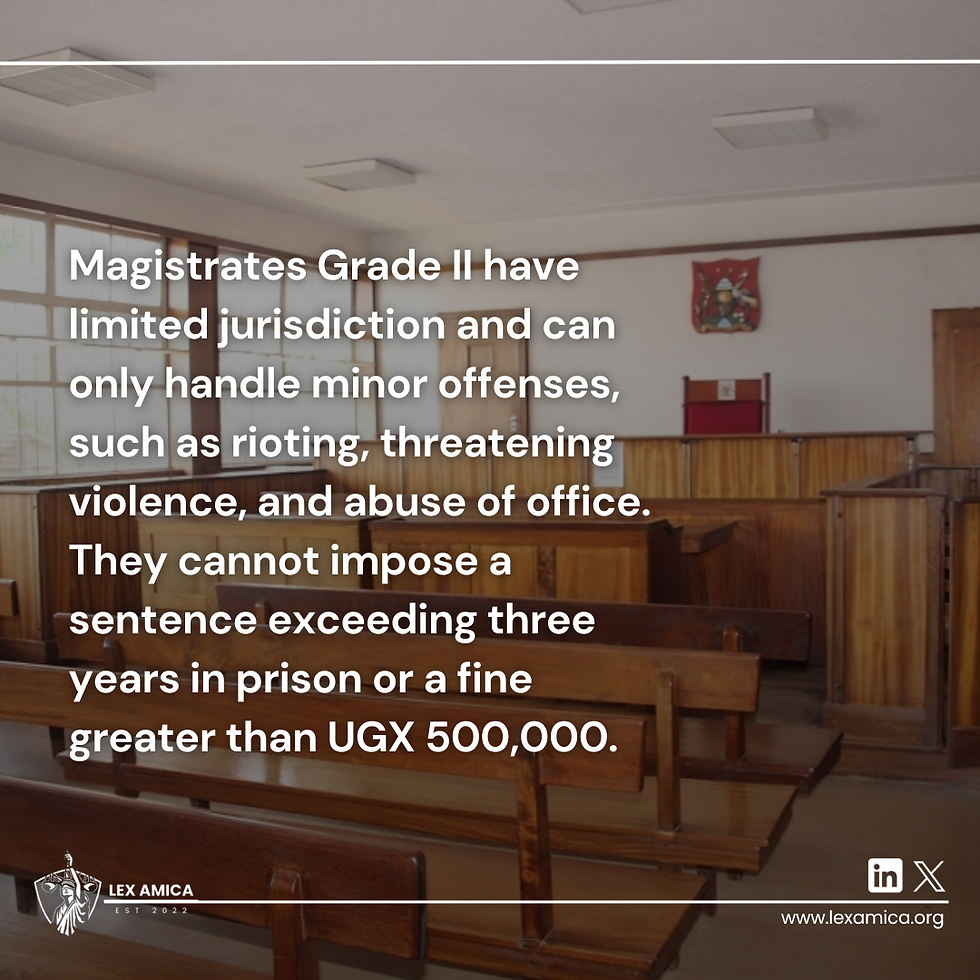Magistrates Courts in Uganda
- Lex Amica

- Sep 7, 2024
- 3 min read
Introduction
Magistrates' Courts form a vital part of Uganda's judicial system, playing a critical role in resolving disputes and delivering justice at a local level. These courts are the most accessible in the country, with a presence in every district. The Magistrates' Courts are divided into different levels, each having specific powers and jurisdictions, which helps in efficiently managing cases based on their nature and severity.

The Structure of Magistrates' Courts
The Magistrates' Courts in Uganda are organized into three levels: the Chief Magistrate’s Court, Magistrate Grade I, and Magistrate Grade II. Each level is designed to handle different types of cases and has its own jurisdictional limits.
Chief Magistrate’s Court
The Chief Magistrate's Court is on of the highest level within the Magistrates' Courts structure. It is presided over by a Chief Magistrate, who must hold a law degree. This court has both original and appellate jurisdiction but operates within specific limits.
The Chief Magistrate can hear and determine a wide range of criminal cases, except those where the maximum penalty is death. This means the Chief Magistrate cannot impose a death sentence but can pass any other sentence authorized by law. For example, they can handle cases of theft, assault, or fraud but not cases involving capital offenses like murder.
In civil matters, the Chief Magistrate has the authority to hear cases where the value of the subject matter does not exceed UGX 50 million. However, for cases involving conversion (wrongful possession of property), damage to property, or trespass, there is no monetary limit. Additionally, in cases governed purely by civil customary law, the Chief Magistrate’s jurisdiction is unlimited.
The Chief Magistrate’s Court also hears appeals from Grade I Magistrates' Courts within its area of jurisdiction. This provides a mechanism for reviewing decisions from lower courts, ensuring that justice is properly administered. Furthermore, the Chief Magistrate has supervisory powers over all Magistrates' Courts within their jurisdiction and can review records from these courts to prevent any miscarriage of justice.

Magistrate Grade I
The Magistrate Grade I courts are the second level within the Magistrates' Courts structure. These courts are presided over by Magistrates who are qualified lawyers with both a law degree and a Diploma in Legal Practice. They are typically located at the district headquarters.
A Magistrate Grade I can handle civil cases where the value of the dispute does not exceed UGX 20 million. This allows them to manage a wide range of civil matters, including contract disputes, debt recovery, and land disputes, within this financial limit.
For criminal cases, a Magistrate Grade I can decide on any matter except those punishable by death or life imprisonment. The maximum sentence they can impose is ten years in prison. In cases involving civil customary law, they have unlimited jurisdiction, similar to the Chief Magistrate.
Magistrate Grade II
The Magistrate Grade II courts represent the third level within the Magistrates' Courts structure. This level is gradually being phased out, and only a few Magistrates Grade II remain in the system today.
Magistrates Grade II have very limited jurisdiction and can only handle minor offenses such as rioting, threatening violence, and abuse of office. Their sentencing powers are also limited; they cannot impose a sentence longer than three years in prison or a fine exceeding UGX 500,000. This level primarily deals with petty offenses and low-value civil matters.

The Importance of Magistrates' Courts
Magistrates' Courts are essential for ensuring that justice is accessible to everyone in Uganda. Here’s why they matter:
Accessibility: With courts available in every district, citizens do not need to travel far to access justice. This decentralization of the judicial system makes it easier for people to seek redress for their grievances.
Efficiency: By handling most civil and criminal cases, Magistrates' Courts help reduce the burden on higher courts, such as the High Court and the Court of Appeal. This helps in speeding up the judicial process and reducing case backlogs.
Supervision and Oversight: The Chief Magistrate’s supervisory role over lower courts ensures consistency and fairness in the administration of justice. It provides an internal mechanism for review and correction of errors.
Conclusion
Magistrates' Courts in Uganda play a crucial role in maintaining law and order by providing an accessible, efficient, and fair judicial process. Understanding their structure and functions helps citizens navigate the legal system better and ensures that their rights are protected. Whether handling minor offenses or complex civil disputes, these courts are vital to the administration of justice in Uganda.




Comments